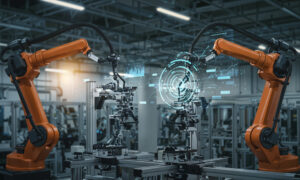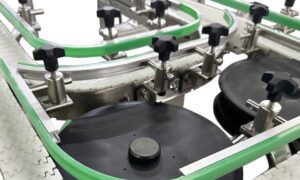Overall Equipment Effectiveness (OEE) is a critical KPI for manufacturing efficiency. Put simply, OEE is an essential measure of the performance of manufacturing machinery and processes. By gauging actual performance against optimum capabilities, well-implemented OEE can – at a glance – determine equipment effectiveness.
This has never been an easy thing to achieve, but now smart technologies have risen to the challenge. In this guide, we consider the importance of OEE in the manufacturing process and how smart technologies have revolutionized how we approach it.
Understanding OEE and its components
As mentioned, OEE is a comprehensive metric used in manufacturing to assess the efficiency and effectiveness of equipment. However, this oversimplified definition hides the underlying complexities and benefits of the process.
OEE is a crucial tool for identifying losses, benchmarking progress, and improving the productivity of manufacturing processes. OEE breaks down this complexity into understandable components, each highlighting a different aspect of performance:
- Availability: This measures the time the equipment is actually available for production versus planned production time. It factors in events like equipment failures and setup times.
- Performance: This component assesses whether the manufacturing process is running at its maximum speed. It considers factors like minor stoppages and reduced speed.
- Quality: Quality measures the proportion of good parts produced versus the total parts produced. It takes into account any products that don’t meet quality standards and must be scrapped or reworked.
Analyzing these components and – importantly – understanding what the data is saying is the key to how effective OEE improves manufacturing efficiency.
Overview of smart manufacturing technologies
We are living in an age where the emergence of technologies like AI and the Internet of Things (IoT) are truly living up to the term “disruptive”. These are revolutionizing how we interact with technology and what technology can do for us.
In manufacturing terms, smart technologies are blurring the lines between digital and physical processes. The increasing integration of these “realms” is key to reducing waste, improving efficiency, and enhancing quality.
Among the technologies leading the charge are:
- Industrial internet of things (IoT): a subset of IoT, these devices collect and analyze data from manufacturing equipment, providing insights into performance and maintenance needs. This real-time data helps in predictive maintenance and efficient resource management.
- Artificial intelligence (AI) and machine learning (ML): AI and ML algorithms analyze vast amounts of data to optimize production processes, predict equipment failures, and enhance quality control. They enable smarter decision-making and process automation that are playing a substantial role in driving future growth across industry as a whole.
- Robotics and automation: Robotics improve precision and efficiency in manufacturing. Automated systems can handle repetitive tasks, reduce human error, and work in environments unsuitable for humans.
- Additive manufacturing (3D printing): This technology allows for rapid prototyping, customization, and on-demand production. It reduces waste and enables the creation of complex geometries that are difficult with traditional manufacturing methods.
- Digital twins: Digital twins are virtual replicas of physical systems. They are used for simulation, analysis, and control, helping to predict performance and optimize operations.
- Cyber-physical systems (CPS): These systems integrate computation, networking, and physical processes. CPS in manufacturing leads to improved process control and adaptive responses to changing conditions.
Each of these technologies plays a vital role in enhancing the capabilities of manufacturing processes, leading to increased OEE and overall productivity.
Key roles of OEE software in smart manufacturing
Advanced OEE software can be considered the heart of efficient manufacturing processes. In essence, such software acts as the bridge between traditional manufacturing mechanisms and the advanced capabilities of smart technologies. By using these tools, manufacturers can gain insights into the effectiveness of manufacturing processes that were previously unimaginable.
Among the key roles that OEE software is playing are:
- Real-time data analysis: Enables immediate understanding of production issues, facilitating quick decision-making.
- User-friendly interface: A user-friendly OEE dashboard ensures ease of use for all team members, regardless of their technical expertise.
- Comprehensive reporting: Provides detailed insights into production efficiency, highlighting areas for improvement.
- Integration capabilities: Allows seamless connection with other manufacturing systems and technologies, enhancing overall process synergy.
Of course, in the age of cloud computing, real-time access to this data from any location is also a huge bonus.
Challenges with integrating smart technologies in manufacturing
While there are definite and palpable benefits to OEE and smart technologies in manufacturing, there are challenges to be faced along the way. Key among them are:
- Skilled workforce: Requires a workforce proficient in new technologies.
- Cybersecurity risks: Increased reliance on digital systems heightens vulnerability to cyber threats.
- Initial investment: Significant upfront investment may be needed for technology upgrades.
These challenges prove that there is no such thing as a free lunch. However, despite these and other challenges the long-term efficiencies and quality improvements make the integration of smart technologies a strategic move for forward-thinking manufacturers.
Summing up
The integration of smart technologies has revolutionized OEE and in doing so has led to more efficient and simplified manufacturing processes. In other words, it has made “making it” easier.
While challenges exist, the long-term benefits of improved efficiency, quality, and competitiveness are undeniable. This shift represents the future of manufacturing and will increasingly become a necessity for manufacturers who wish to remain relevant in the modern world.
As AI continues to evolve into 2024, the future performance of OEE tools will continue to redefine how we manufacture our goods.



































